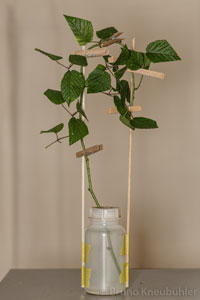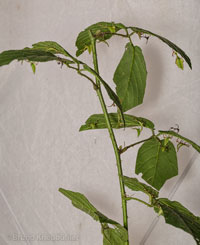
For a long time Phyllium have been our personal bugaboo amongst phasmids. We failed for example with Phyllium giganteum, even though we were quite successful with many other "difficult" phasmid species. Therefore we've avoided breeding Phyllium for quite some time. But then our colleague and friend Joachim Bresseel (BE) brought back eggs of a supposedly new Phyllium species from Vietnam (Phyllium sp. "Cat Tien"). And to our dismay he asked us to breed that culture. Fortunately we accepted the challange, as this was the trigger to try out new ways to breed Phyllium. With stunning results. Just some simple adjustments, and all Phyllium species we have been breeding since thrive very well. Even Phyllium giganteum is now a very easy species for us.
Hopefully our simple approach, the Free-Standing Setup (FSS), will help other breeders with their "problematic" Phyllium species too:
- For the FSS we need a spacious cage so that one can put big / long enough food plant twigs inside. The food plant leaves shall not touch or be too close to the cage walls (distance > 5 cm) - hence it is called Free-Standing. This trait is the main characteristic of this simple apprach. Netting cages are suited very well for this purpose, cause they are very lightweight and hardly block the light. We use socalled Aerariums (which are available from Bioform in Germany or Papa Papillon in Switzerland). Although such Aerariums are not really cheap, they are of great quality, durable and they have a "see-through" side. Yet other (cheaper) netting cages should also do the trick
- Cut away all the edges of the food plant leaves in the cage for the nymphs in the 1st and 2nd instar

- Fix two wooden sticks to the water jar, in which you put the food plants. This can be done with rubber bands or an adhesive tape
- Fix the food plant(s) with clothes pegs to the wooden sticks. This way a longer food plant stem can be fixed in a curve or even a full loop onto both wooden sticks
- The food plant leaves shall not touch the wall or ceiling of the cage (that's why this setup is called free-standing). If leaves stick out too far, then fix those with clothes pegs to the wooden sticks or the food plant stem itself

- As with any phasmid culture, avoid overcrowded situations. Population stress in overcrowded cages, is one of the main reasons for breeding failures
- A humidity level of about 65 to 70 % RH (within the cage) is good enough, and nymphs will moult with ease
- when the humidity level dropped to about 40 - 45%, then only I experienced a few mismoults while still most of the nymphs moulted perfectly. This clearly shows how resilient Phyllium nymphs are against a lower humidity, and that a very high humidity is not needed (although not wrong either)
- But to be on the safe side, we try to keep the humidity ≥ 55% RH. For some breeders this could be an issue in winter, if their cages are in a heated room
- if humidity drops too low (< 50%), then reduce the ventilation areas on the netting cage. For example with a big clear, translucent plastic bag. Such a bag can conveniently be fixed to the netting cage with clothing pegs or (better) with socalled binder clips. Just cut some openings / bigger holes in the plastic bag for example where the netting cage's opening is. If humidity is still not high enough (> 60%), then a wet paper tissue in a big pot saucer on the cage floor should do the trick
- If you keep your Phyllium in a cage with reduced ventilation areas, then raise humidity either with a wet paper tissue or by spraying them occacionally. Both is often too much
- If possible, use a ventilator to create a soft breeze at intervals of about 15 minutes on / off
- Put the netting cage in a place with light. Phyllium should not be kept in complete dark rooms, as they usually crawl towards light
- Temperature range from about 20° C (night or winter) to about 25° C (day or summer). Try to avoid temperatures above 28° C. I do never have as many losses as during a summer's heatwave, when temperatures in my phasmid room reach 30° C or even more

- Phyllium nymphs are rather active during the first few days after hatching, running around quite a lot. Out in nature they hatch from eggs laying on the forest floor - while their food plants are high up in the forest canopy. So running (up towards the light, where the food plants are) is a necessity for them. They really run for life. Therefore many nymphs will leave during their "running-phase" the free-standing plant and end up on the cage's wall again and again. Thus every evening, just after dusk, we put all those strolling nymphs back on the Free-Standing food plants
- Why to put them back just after dusk? Freshly hatched Phyllium nymphs are mainly day-active and sit quietly during the night. So they will "wake up" on the free-standing food plant in the morning, and first thing they do is to explore that plant... "can I eat this?"
- Spray with chlorine-free (!) water. Best time for spraying is in the evening, just before or after dusk, when the strolling nymphs have been put back on the free-standing food plant
- We use a tropical black-water conditioner in the spraying water (50 drops per liter, Dennerle TR7 Tropic or Tetra ToruMin). It seems that this "black water" supplement helps getting Phyllium nymphs to start feeding. Maybe this adds some flavor which they like
- one can spray Phyllium directly, and also their food plants and cage. In our setup they are soaking wet after we sprayed.
- Important is that the water sprayed dries up within a few hours. Do not keep Phyllium (neither nymphs nor adults) in a constantly wet environment
- once the nymphs settled down and started to feed, then reduce spraying intervals to about once a week
- Once the nymphs start to feed, they usually settle down quickly and stop running around
- Still it can take 4 - 8 days before nymphs start feeding after hatching. So don't give up on them, Phyllium nymphs are very hardy indeed
- during the first weeks, offer them fresh food plants every week
- When the nymphs are a bit older (like in L3) you can arrange the food plants differently in their cage, or put the nymphs into a Faunabox. By then the Free-Standing Setup is no more needed
The FSS works like a charm for us, and so far we could easily breed more than 20 different Phyllium species / cultures in the past. Losses amongst nymphs are in our setup < 5%. Even species or cultures which are difficult for most breeders, proof to be easy with the FSS - like for example Phyllium rubrum "Tapah" of Phyllium giganteum "Tapah"

Why does the FSS work?
When kept in a FSS setup, it seems as if Phyllium nymphs are more tempted to start feeding, as they are constantly in contact with the leaves. Especially when they climb over a leaf edge, then they try out whether this is something edible.
Another reason could be that the (micro-) climatic FSS conditions suits their needs better, as Phyllium species are suspected to be predominantely tree-top dwellers.
Another FSS advantage in a netting cage is that the light reaches the food plants somewhat evenly from different directions. Phyllium have an inclination to climb in the direction from where the most light comes. This behaviour can be observed particularly with (adult) females. This can result in a situation where many Phyllium specimens flock together in the same area, although there would be more than enough "free" leaves in other parts of the cage. And this flocking together increases "behavioural cannibalism". But when the food plants are somewhat evenly lit-up from different directions, then they will spread out more evenly to the different leaves, which in turn reduces the danger of "behavioural cannibalism".
Please also read these inspiring lines A breeder's notes on the Free-Standing Setup by Tim van Molle (Belgium)